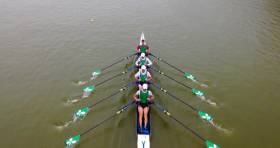Displaying items by tag: Under23 Championships
#Rowing: The Ireland lightweight quadruple of Niall Beggan, Stephen O’Connor, Andrew Goff and Shane O’Connell qualified for the A Final at the World Under-23 Championships today by finishing third in their semi-final. Austria won the race in Plovdiv, Bulgaria in a new best time for the Championships. Ireland, who were down the field in the early stages, had a very strong middle of the race and coming up to the line they fought it out with Italy and Germany for the crucial second and third spots. Germany lost out, taking fourth.
The race was run in temperatures of over 30 degrees centigrade and good conditions – the best time was bettered immediately by the winners of the next semi-final, Switzerland.
World Rowing Under-23 Championships, Day Three (Irish interest)
Men
Lightweight Quadruple Sculls – Semi Finals (First Three to A Final; rest to B Final) – Semi-Final One: 1 Austria 5:47.86, 2 Italy 5:48.02, 3 Ireland (N Beggan, S O’Connor, A Goff, S O’Connell) 5:48.39; 4 Germany 5:49.57.
Semi-Final Two: 1 Switzerland 5:47.26, 2 Britain 5:49.31, 3 France 5:50.52.
#Rowing: Ireland’s lightweight quadruple won their heat at the World Rowing Under-23 Championships in Plovdiv in Bulgaria today. The crew of Niall Beggan, Stephen O’Connor, Andrew Goff and Shane O’Connell gave an outstanding performance. They outpaced early rivals Denmark, and when Britain challenged in the second half they more than matched them to win by 2.73 seconds. Britain and third-placed Spain qualified directly for the semi-finals.
David O’Malley and Shane Mulvaney finished second in their heat and must come through a repechage on Thursday to make the A Final of the lightweight men’s pair. The winner of each heat would qualify for the A Final. Ireland’s crew looked well in contention as they disputed the lead with Italy until 1,000 metres. But the Italy crew upped their rate and left Ireland behind. Their winning time was almost 12 seconds faster than the crew which won the second heat, Britain.
World Rowing Under-23 Championships, Plovdiv, Bulgaria (Irish interest)
Men
Lightweight Pair – Heat One (First to A Final; rest to Repechage): 1 Italy 6:41.77; 2 Ireland (S Mulvaney, D O’Malley) 6:47.52.
Lightweight Quadruple Sculls – Heat One (First Three to A/B Semi-Finals; rest to Repechage): 1 Ireland (N Beggan, S O’Connor, A Goff, S O’Connell) 5:59.39, 2 Britain 6:02.12, 3 Spain 6:03.16.

























































